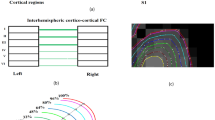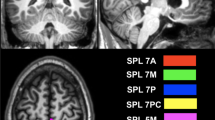Abstract
The relevance of correlations between blood oxygenation level dependent (BOLD) signal changes across the brain acquired at rest (resting state networks, or RSN) to functional networks was tested using two quantitative criteria: (1) the localisation of major RSN correlation clusters and the task-related maxima defined in BOLD fMRI signal changes from the same subjects; and (2) the relative hemispheric lateralisation (LI) of BOLD fMRI signal changes in sensorimotor cortex. RSN were defined on the basis of signal changes correlated with that of a “seed” voxel in the primary sensorimotor cortex. We found a generally close spatial correspondence between clusters of correlated BOLD signal change in RSN and activation maxima associated with hand movement. Conventional BOLD fMRI during active hand movement showed the expected wide variation in relative hemispheric lateralisation of LI for sensorimotor cortex across the subjects. There was a good correlation between LIs for the active hand movement task and the RSN (r=0.74, p<0.001). The RSN thus define anatomically relevant regions of motor cortex and change with functionally relevant variations in hemispheric lateralisation of sensorimotor cortical interactions with hand movement.




Similar content being viewed by others
References
Attwell D, Iadecola C (2002) The neural basis of functional brain imaging signals. Trends Neurosci 25:621–625
Beckmann C, Smith S (2004) Probabilistic independent component analysis for functional magnetic resonance imaging. IEEE Trans Med Imag 23:137–152
Binder JR, Frost JA, Hammeke TA, Bellgowan PSF, Rao SM, Cox RW (1999) Conceptual processing during the conscious resting state. A functional MRI study. J Cogn Neurosci 11:80–95
Biswal B, Yetkin FZ, Haughton VM, Hyde JS (1995) Simultaneous assessment of flow and BOLD signals in resting-state functional connectivity maps. NMR Biomed 10:165–170
Cordes D, Haughton VM, Arfanakis K, Carew JD, Tursky PA, Moritzk CH, Quigley MA (2000) Mapping functionally related regions of brain with functional connectivity MR imaging. AJNR Am J Neuroradiol 21:1636–1644
De Luca M, Beckmann C, Clare S, Behrens T, De Stefano N, Matthews PM (2002) Low frequency signals in fMRI-resting state networks and the intensity normalization problem. Proc Int Soc Magn Reson Med 1459
Goldman RI, Stern J, Engel J, Cohen M (2002) Simultaneous EEG and fMRI of the alpha rhythm. Neuroreport 13:2487–2492
Jenkinson M, Smith S (2001) A global optimisation method for robust affine registration of brain images. Med Image Anal 5:143–156
Jenkinson M, Bannister PR, Brady M, Smith S (2002) Improved optimization for the robust and accurate linear registration and motion correction of brain images. Neuroimage 17:825–841
Johansen-Berg H, Rushworth MFS, Bogdanovic MD, Kischka U, Wimalaratna S, Matthews PM (2002) The role of ipsilateral premotor cortex in hand movement after stroke. Proc Natl Acad Sci USA 99:14518–14523
Kiviniemi V, Jauhiainen J, Tervonen O, Paakko E, Oikarinen J, Vainionpaa V, Rantala H, Biswal B (2000) Slow vasomotor fluctuation in fMRI of anesthetized child brain. Magn Reson Med 44:373–378
Kiviniemi V, Kantola JH, Jauhiainen J, Hyvarinen A, Tervonen O (2003) Independent component analysis of nondeterministic fMRI signal sources. Neuroimage 19:253–260
Lauritzen M (2001) Relationship of spikes, synaptic activity, and local changes of cerebral blood flow. J Cereb Blood Flow Metab 21:1367–1383
Lauritzen M (2003) Brain function and neurophysiological correlates of signals used in functional neuroimaging. J Neurosci 23:3972–3980
Lee M, Reddy H, Johansen-Berg H, Pendlebury S, Jenkinson M, Smith SM, Palace J, Matthews PM (2000) The motor cortex shows adaptive functional changes to brain injury from multiple sclerosis. Ann Neurol 47:606–613
Leopold DA, Murayama Y, Logothetis NK (2003) Very slow activity fluctuations in monkey visual cortex: implications for functional brain imaging. Cereb Cortex 13:422–433
Logothetis NL (2002) The neural basis of the blood-oxygen-level-dependent functional magnetic resonance imaging signal. Philos Trans R Soc Lond B Biol Sci 357:1003–1037
Lowe Phillips MD, Lurito JT, Mattson D, Dzemidziz M, Mathews VP (2002) Multiple sclerosis: low-frequency temporal blood oxygen level-dependent fluctuations indicate reduced functional connectivity initial results. Radiology 224:184–192
Lowe MJ, Dzemidziz M, Lurito JT, Mathews VP, Phillips MD (2000) Correlations in low-frequency BOLD fluctuations reflect cortico-cortical connections. Neuroimage 12:582–587
Matthews PM, Arnold DL (2001) Magnetic resonance imaging of multiple sclerosis: new insights linking pathology to clinical evolution. Curr Opin Neurol 14(3):279–87
Mitra PP, Ogawa S, Strupp JP, Anderson P, Ugurbil K (1997) The nature of spatiotemporal changes in cerebral hemodynamics as manifested in functional magnetic resonance imaging. Magn Reson Med 37:511–518
Moosmann M, Ritter P, Krastel I, Brink A, Thees S, Blakenburg F, Taskin B, Obrig H, Villinger A (2003) Correlates of alpha rhythm in functional magnetic resonance imaging and near infrared spectroscopy. Neuroimage 20:145–158
Poline J-B, Worsley KJ, Evans AC, Friston K (1997) Combining spatial extent and peak intensity to test for activations in functional imaging. Neuroimage 5:83–96
Reddy H, Narayanan S, Woolrich M, Mitsumori T, Lapierre Y, Arnold DL, Matthews PM (2000) Evidence for adaptive functional changes in the cerebral cortex with axonal injury from multiple sclerosis. Brain 123(Pt 11):2314–2320
Reddy H, De Stefano N, Mortilla M, Federico A, Matthews PM (2002) Functional reorganization of motor cortex increases with greater axonal injury from CADASIL. Stroke 33:502–508
Smith SM (2002) Fast robust automated brain extraction. Hum Brain Mapp 17:143–155
Woolrich M, Ripley BD, Brady JM, Smith SM (2001) Temporal autocorrelation in univariate linear modeling of FMRI data. Neuroimage 14:1370–1386
Zhang R, Zuckerman JH, Iwasaki K, Wilson TE, Crandall CG, Levine BD (2002) Autonomic neural control of dynamic cerebral autoregulation in humans. Circulation 106:1814–1820
Acknowledgements
We acknowledge the generous support of the UK Medical Research Council (PMM), UK Engineering and Physical Science Research Council (SMS), the Multiple Sclerosis Society of Great Britain and Northern Ireland (PMM). MDL is a student in the European Ph.D. Programme in the Neurosciences based in the University of Siena.
Author information
Authors and Affiliations
Corresponding author
Rights and permissions
About this article
Cite this article
De Luca, M., Smith, S., De Stefano, N. et al. Blood oxygenation level dependent contrast resting state networks are relevant to functional activity in the neocortical sensorimotor system. Exp Brain Res 167, 587–594 (2005). https://doi.org/10.1007/s00221-005-0059-1
Received:
Accepted:
Published:
Issue Date:
DOI: https://doi.org/10.1007/s00221-005-0059-1




